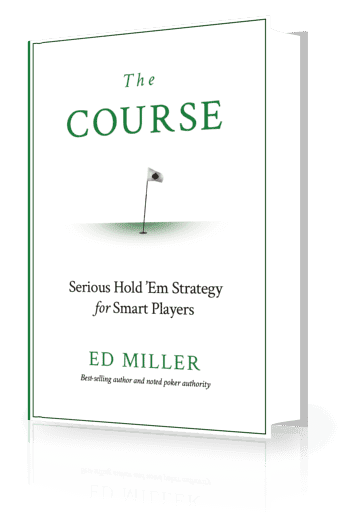This is the ninth book written by Ed Miller, concerning Texas Hold’Em poker cash games. Some of the earlier books were written in concert with other authors, but all the recent ones were written solely by Miller, and concern the play of the no limit, cash version of the game. Ed is a very bright, well-educated fellow, very experienced in $1-2, $2-5 and $5-10 no limit games as played in Las Vegas, and across the country. He is a highly respected player, author and teacher.
The Course is designed for players at these levels, to enable them to win the games they currently play, and perhaps move up a level successfully. New concepts are presented in an interesting and coherent manner, and many are new ideas that even very experienced players may not have considered before. Ed has a unique ability to see what others don’t know or understand, and to lead them to the right questions to ask, and to the right answers. That ability shows up in this book.
While many of the concepts are not simple, Ed presents them in an understandable way that makes them easy to absorb and retain, and put into your game. There is virtually no “math” to speak of, though the needed math concepts are woven into the material seamlessly. “Math-phobics” need not fear!
An over-riding theme throughout the book is the idea that almost all low-level Hold’em players at these games play far too many hands, a fact which we need to understood and use advantageously. This central idea shows up one way or another in every one of the “skills” throughout the book.
The Course is arranged into three basic sections; one each for $1-2, $2-5, and $5-10 NLHE. Within each section there are several chapters, each presenting “skills” the player will need for success at that level. For example, in the $1-2 section, three “skills” are presented: preflop play, avoiding paying off opponents, and understanding the real value of our own hand, relative to likely hands the opponent might be playing. Each of the skills feeds into the next, for use as a building block.
The focus of the sections differs, too:
The first section, on $1-2, has the reader concerned primarily with his own cards, the problems he may have, and how best to play.
The second section, for $2-5 NL contains four skills and focusses much more on the other players in the game, what cards they may be playing, what their strategies might be, and how to use that information productively. Betting skills, tells, reading the opponent and evaluating the texture of the board cards are key ideas in this section, along with understanding one’s own emotions effectively.
The third section is devoted to an introduction to $5-10 NLHE, and to the skills required for success at that level. The key factor here is coping with aggression, taking on “professional players,” and playing with deep stacks for much larger sums than in the earlier two sections.
Each of the sections ends with a “Hand Quiz” in which hands are presented as unknowns, with discussion, to emphasize points made in that section.
The book is not a difficult read. Quite the contrary, in fact. I found it very interesting and enjoyable, and was able to gather a number of useful ideas for my own game. I believe even knowledgeable, experienced players will be pleasantly surprised with the amount of useful new information they find in the book.
My prediction is The Course will be very popular and will soon be known as one of the very best books on No-Limit Cash games. It was a pleasure to be able to review the book!
#excellent; #thenuts; #lovedit!.
Bill Conklin


When will this be available for Kindle?
It actually works on Kindle already! Purchasing The Course through our site gets you the .PDF, .MOBI, and the .EPUB (which is the Kindle-preferred format).
I purchased this book after learning about Ed Miller. I absolutely love it. Very clear and concise. I’m very serious about my game and while newer to poker, I’ve read 13 poker books (each one highly respected and rated) in the last 6 months and my concern was simply learning about known principles or tactics. This book provided a unique perspective and it was definetely one that I was not familiar with. I’m not about to start another one of Ed Millers books, “Playing the Player.”
There is no book that has helped me more to think through where I am at and where I should be going in my poker game.
It has helped me to begin to plan my hands.
It has helped to understand more complicated books like Sklansky’s and Miller’s “No Limit Hold-em: Theory and Practice and Flynn, Mehta, and Miller “Professional No-Limit Hold-em”. In other words it is the kind of book that helps you to think about other books and how you get good enough to play at the level of other books.
I have in effect read this book two times and will probably read it once more. I am almost through with the pro-video course that is a companion to the book. The videos add to the book, they don’t copy the book. The videos give you a new way to look at what the book is teaching. Because of the videos I will end up going through Miller’s book a third time.
But it is not enough to read this book. The book must be used to set poker goals. You must practice each skill. After you read the book I suggest you work on one skill at a time in each session until you get it. If you are having a hard time at one skill or another, break the skill down into 3 or 6 components and just practice that part of the skill. That is what I am doing and it has helped me to focus my playing. I can see how I’m improving every time I use the book.
Of course the above means that you must take notes on the book and the video series.
Learning is like a coin.
How many sides does a coin have?
A coin as three sides…
Precept is the side that most see when they can not transcend the coin.
This is the world of the doers, a world of simple tricks and tips.
Learning is seen here as an object to be mastered, like a tool.
Concept is the side that few see when they transcend the coin.
This is the world of thinkers, a world of abstract entities.
Learning is seen here as a system that can be conquered and questioned.
And depth is the third side, the side that says that knowledge
Can not be given, only taken. The side that virtually no one
Considers when asked “How many sides does a coin have?”
The contributors to our learning of Poker can be put on a spectrum.
Sklansky is at one end of that spectrum: the theoretical end
Where basic but rigid empirical principles were laid as a foundation
Miller is at the other end… the vulgarization end
Where flexible rules were articulated and used to point the way
Harrington and a limited number of others are somewhere in between.
Nothing is more practical than a good theory
Poker is both a science and an art, yet it is none of the above
Poker is a predator games that constitutes an additional layer
To Darwin’s theory of evolution that makes sense of everything that lives
The challenge is not to learn science, art, or poker.
The challenge is to learn to think like a scientist,
An artist, or a poker player
It is because Mendeleev table of elements was a spiral and not a table
That the atomic number and mass of elements not yet discovered could be predicted
It is because poker can be seen as a human abstraction of what all animal life is
That the game is so fascinating and that it gives a hint at the fate of the human race
very interesting, i think i shall try it out, any help is welcome, gbg & p